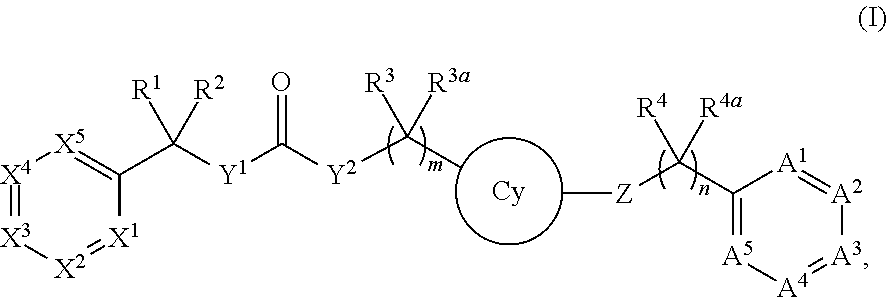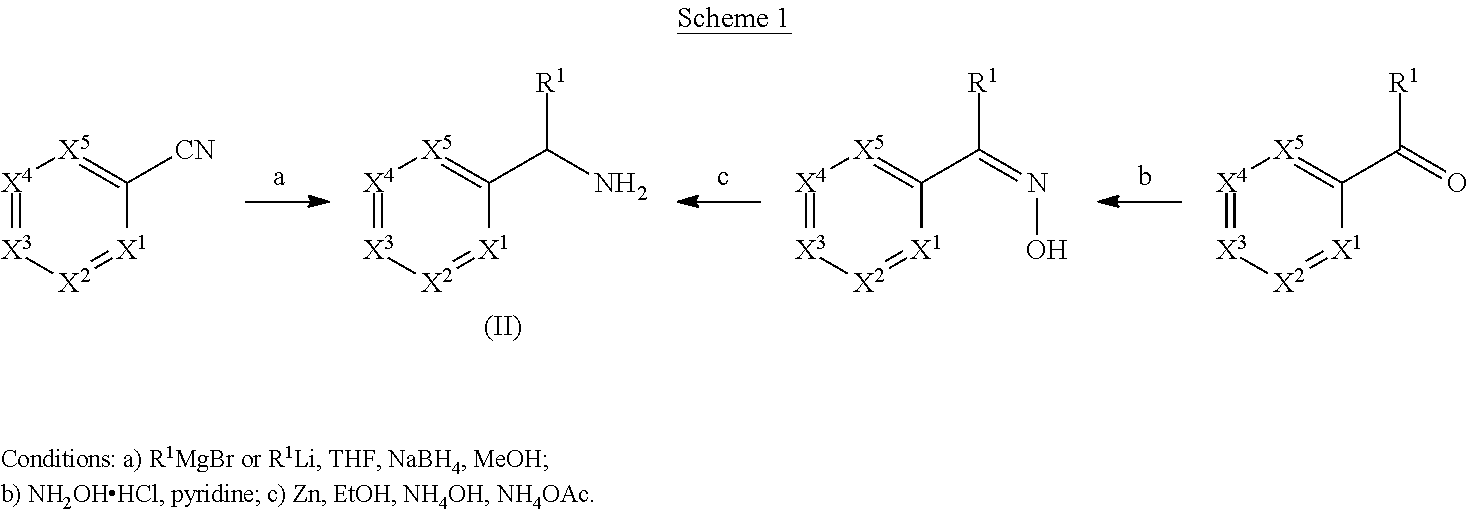Compounds and methods
a technology of steroid hormone and nuclear receptor, which is applied in the field of compound and method, can solve problems such as eaemelioration
- Summary
- Abstract
- Description
- Claims
- Application Information
AI Technical Summary
Benefits of technology
Problems solved by technology
Method used
Image
Examples
example 1
N-((2-chloro-4-methylphenyl)(phenyl)methyl)-2-(4-(pyridin-3-ylmethoxy)phenyl)acetamide
[0237]
(a) (2-chloro-4-methylphenyl)phenylmethanamine
[0238]To a solution of 2-chloro-4-methylbenzonitrile (0.50 g, 3.31 mmol) in anhydrous THF (7 mL) at 0° C. was added 1 M solution of phenyl magnesium bromide in THF (4.96 mL, 4.96 mmol) over 10 minutes and the resulting mixture was warmed to rt. The reaction mixture was stirred at rt for 30 minutes followed by heating to 60° C. and stirred at the same temperature for 2 h. After completion of the imine formation, the reaction mixture was cooled to 0° C. and methanol (10 mL) was added very slowly followed by sodium borohydride (0.188 g, 4.96 mmol). The resulting mixture was warmed to rt and stirred overnight. After completion of the reaction, solvent was removed under vacuum and water (20 mL) was added into the reaction mixture and extracted with ethyl acetate (2×35 mL). The combined organic layers were dried over Na2SO4 and concentrated. The product...
example 2
N-((4-chloro-3-methylphenyl)(phenyl)methyl)-2-(4-((2-methylpyridin-3-yl)methoxy)phenyl)acetamide
[0242]
(a) (2-methylpyridin-3-yl)methanol
[0243]To the suspension of LiAlH4 (2.62 g, 68.8 mmol) in THF (50 mL) was added the solution of methyl 2-methylnicotinate (5.2 g, 34.4 mmol) in THF (10 mL) slowly at 0° C. After the addition, the resulting mixture was stirred at rt overnight. Water (2.62 mL), 2 M aq. NaOH (5.2 mL), and H2O (7.86 mL) were added successively. Then the reaction mixture was stirred at rt for 30 min and the solid precipitated was removed by filtration. The filtrate was concentrated under reduced pressure and the title compound was used in the next step without further purification. LCMS-P1: 124, [M+H]+.
(b) 3-(chloromethyl)-2-methylpyridine
[0244]To the solution of (2-methylpyridin-3-yl)methanol (2.4 g, 19.5 mmol) in dichloromethane (20 mL) was added SOCl2 (3.1 g, 24 mmol) dropwise at 0° C. After stirring at rt for 2 h, the solvent was evaporated in vacuum and the crude tit...
example 3
N-((2,4-dimethylphenyl)(pyridin-2-yl)methyl)-2-(4-((2-methylpyridin-3-yl)methoxy)phenyl)acetamide
[0249]
[0250]To the solution of (2,4-dimethylphenyl)(pyridin-2-yl)methanamine hydrochloride (60 mg, 0.23 mmol) in DMF (3 mL) was added 2-(4-((2-methylpyridin-3-yl)methoxy)phenyl)acetic acid (75 mg, 0.29 mmol), EDC (56 mg, 0.29 mmol), HOBt (39 mg, 0.29 mmol), then DIPEA (68 mg, 0.53 mmol). The resulting mixture was heated at 45° C. overnight, the mixture was poured into water, extracted with EtOAc (5 mL×2), and the combined organic layer were washed with brine, dried with Na2SO4, and evaporated in vacuum. The residue was purified by preparatory HPLC using 10-100% water / acetonitrile with 0.1% TFA to afford the title compound as a white solid (7 mg, 6%). MS: 452 [M+H]+. 1H NMR (400 MHz, DMSO-d6) δ ppm 8.82 (d, J=8.4 Hz, 1H), 8.49 (d, J=4.0 Hz, 1H), 8.39 (dd, J=1.6 Hz, 4.8 Hz, 1H), 7.77-7.74 (m, 2H), 7.31-7.18 (m, 5H), 6.96-6.90 (m, 5H), 6.21 (d, J=8.0 Hz, 1H), 5.08 (s, 2H), 3.47 (s, 2H), 2.5...
PUM
| Property | Measurement | Unit |
|---|---|---|
| enantiomeric excess | aaaaa | aaaaa |
| enantiomeric excess | aaaaa | aaaaa |
| enantiomeric excess | aaaaa | aaaaa |
Abstract
Description
Claims
Application Information
 Login to View More
Login to View More - R&D
- Intellectual Property
- Life Sciences
- Materials
- Tech Scout
- Unparalleled Data Quality
- Higher Quality Content
- 60% Fewer Hallucinations
Browse by: Latest US Patents, China's latest patents, Technical Efficacy Thesaurus, Application Domain, Technology Topic, Popular Technical Reports.
© 2025 PatSnap. All rights reserved.Legal|Privacy policy|Modern Slavery Act Transparency Statement|Sitemap|About US| Contact US: help@patsnap.com



